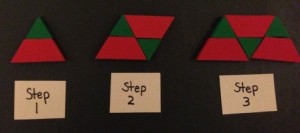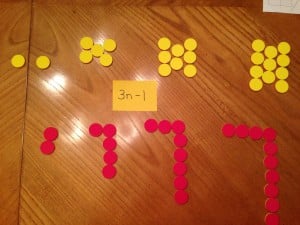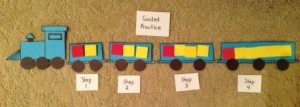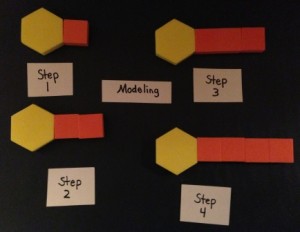by Cindy Elkins, OK Math and Reading Lady
For the teachers in OK, there have been many changes to the math standards, called OAS (Oklahoma Academic Standards). For 3rd, 4th, and 5th grades there is a stronger (or new) emphasis on growing patterns in the algebraic reasoning section. As I always advocate, connecting this concept to concrete objects and pictorial representations should happen before students are given a string of numbers and a function table to decipher.
Did you know there is more than one type of pattern?
Repeating Patterns:
- Can be identified with letters to differentiate: ABAB, ABCABC, ABBCABBC, etc.
- Clapping patterns: These are great for younger students. Clap along as you repeat a pattern (for an AB pattern you could clap hands, then touch knees and repeat). This way the children are involving several senses at once. Be creative with your clapping, snapping, and other hand movements.
- With shapes or other objects: square, circle, triangle, square, circle triangle . . . Make sure students identify the “set” or the repeating portion.
- 1, 2, 3 gr0wing pattern
- Growng pattern example
- Growing pattern example
Arithmetic Patterns: These are number sequences which increase (or decrease) by a constant amount. So they are additive or subtractive, even though they may look like multiplication skip counting patterns.
- 2, 4, 6, 8, 10 . . . Rule is +2
- 3, 6, 9, 12, 15 . . . Rule is +3
- 7, 10, 13, 16, 19 . . . Rule is +3
- 65, 60, 55, 50, 45 . . . Rule is -5
Geometric Patterns: These are number sequences which the next number increases by a constant ratio – a multiplied amount.
- 2, 4, 8, 16, 32 . . . Rule x2
- 3, 12, 48, 192, 768 . . . Rule x 4
 Growing Patterns: The previous two types are growing patterns which involve a progression of steps. While primary students would try to extend them, intermediate students should begin looking for an algebraic relationship that exists which would tell them what the pattern would be like at any given point in the pattern (the nth term). Fifth graders in OK are now asked to evaluate expressions with one variable (such as 2n + 3). Students can apply this skill to a visual model of a growing pattern, a function table, and an x/y coordinate graph.
Growing Patterns: The previous two types are growing patterns which involve a progression of steps. While primary students would try to extend them, intermediate students should begin looking for an algebraic relationship that exists which would tell them what the pattern would be like at any given point in the pattern (the nth term). Fifth graders in OK are now asked to evaluate expressions with one variable (such as 2n + 3). Students can apply this skill to a visual model of a growing pattern, a function table, and an x/y coordinate graph.
For 5th grade teachers and beyond (or anyone who wants to refresh some of their knowledge of algebra on this topic), click on this pdf: Growing patterns, functions, graphing. I’ve included lots of pictures of growing patterns, along with accompanying function table, rules, and algebraic formulas. Click here for a free game I developed! (5th – 7th grade) If-Then Game. See extra directions below.
So get out those pattern blocks, color tiles, blocks, toothpicks, etc. and let your students explore growing patterns! Connect with http://www.learnzillion.com for instructional videos on this topic (patterns, algebra, coordinate planes, etc.). GREAT resource for you and your students!
Some extra directions for the If/Then game: You may want to print each set on a different color (helps when a lost game card appears after you have put everything away) and laminate first. There are 7 pages. There is a game board (grid with numbers ranging from 3-50). A couple of options on the game board. This is where students will keep track of their answers: Students can mark directly on it with different colored markers to keep track of who is who. OR you can also laminate it and have students used colored disks to mark their spot. I also highly suggest you laminate the work mat so it can be reused. This provides a place for students to place the dice, the game card, and show their work . Let me know what you think of it (you can comment by clicking on the little speech bubble near the beginning of the article.



Thank you for all the thought you put into your page. Some articles re-affirm what I am already doing and some remind me of what I NEED to be doing. I really appreciate this article on growing patterns, it came at the perfect time as I am getting ready to teach this topic to my students and I was really struggling with how to present it when I first read the standard. I don’t need to be placed in the drawing for the gift card, I am just excited to have this valuable resource available. Thank you!
Thanks, Tanja! The decisions I make about posts to write usually come from questions other teachers have had, especially with the new OAS standards. And for those using Alpha Plus, there needs to be more hands-on application (in my opinion). So that’s one thing I am trying to include. Students need more than just a string of numbers when working with patterns because that’s too abstract.